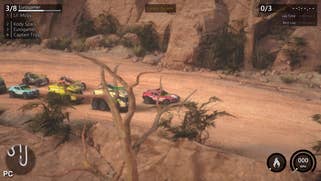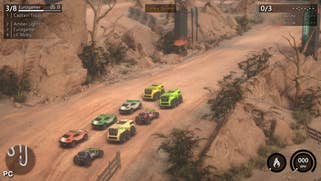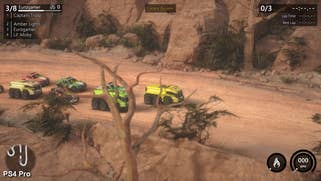Digital Foundry: Hands-on with Mantis Burn Racing on PS4 Pro
The full story behind the new PlayStation's first native 4K 60fps release.
When we were first invited to go hands-on with Mantis Burn Racing - PlayStation 4 Pro's first native 4K title running at 60fps - it's fair to say that we didn't have to think twice about taking up the offer. It was a chance to see a title running at the new hardware's optimal video output, and to talk directly with VooFoo Studios, the Birmingham-based UK developer behind the game.
Best described as a modern 3D refresh of Codemasters' classic Micro Machines series of top-down racing games with a very different visual style, it's perhaps understandable how Mantis Burn Racing manages to hit 60fps at 4K. It doesn't run on the most technologically advanced engine on the market right now - in fact, its underpinnings are based on proprietary VooFoo tech used everywhere from iOS to Android to Wii U - but the end result is a game that looks and feels different and while it's not pushing the state of the art, it still has its own charms.
Various gameplay modes are on offer but the basic gameplay remains constant - it's flat-out circuit racing built upon a solid combination of excellent, dynamic, sweeping camera work and a highly satisfying drift mechanic. The game's visuals are distinctive too - two separate areas are included in the game: an industrial cityscape and a detail-rich rocky environment, though some stages merge the two. The more natural environments are where Mantis Burn Racing's visual really shine - light, shadow, intricate detail and a substantial post-process pipeline combine to produce a great look, with lighting values and indeed textures taken from photography and baked in at a high resolution. It's here where you get your value from the native 4K framebuffer.
The game's based on a forward renderer which also helps in getting this game to run at 60fps in ultra HD, and in terms of visual features, we're told it's identical to both the base PS4 version and indeed the PC game. All of the more expensive visual effects make the jump across to PlayStation 4 Pro, including an impressive depth of field effect that emphasises distance and is particularly effective as background detail drops away as the circuit gains altitude. The only casualty in the move to 4K comes from the omission of anti-aliasing - you get 2x MSAA on the base PlayStation 4, while the rich pixel density and post-processing means that it isn't really required at all at 4K. Perhaps not surprisingly, PS4 Pro owners connected to 1080p displays get a super-sampled version of the 4K output, downscaled to full HD.
Mantis Burn Racing also taps into and modernises Micro Machines' core hook: multiplayer. Online racing supports up to eight players, while local multiplayer is taken care of via two and four-player split-screen. These modes also run at native 4K, which means that the quad-player set-up sees each participant get the same amount of pixel real estate as the base PS4 version. Effectively running two or four times the geometry and game logic takes its toll on frame-rate though: two-player adds a degree of wobble to the game's 60Hz refresh, while four-player sensibly opts for a 30fps lock instead.
We emerged from our meeting with VooFoo with 209GB of 60fps ultra HD captures swiped directly from the HDMI 2.0 port of a PS4 Pro test station (an anonymous-looking piece of kit, rather like a first-gen cable/satellite set-top box), and can confirm that it is indeed running at native resolution with no checkerboarding or other upscaling techniques. By and large, standard single-player gameplay does indeed stick to the 60fps target, but there are occasional drops down to the mid-50s. It's not unduly impactful to gameplay, but owing to the importance of the game's ever-shifting camera angles, the judder is noticeable. The code we played wasn't final-final but it was as good as. Production internally at VooFoo has moved onto DLC, with a new area promised to complement the two already present in the game. The chances are that this is the performance profile of the final game.
On paper though, the technical accomplishment here is impressive. VooFoo has quadrupled resolution over the base PS4 version, and it has done this using a GPU that only has 2.3x the compute power of the older hardware and only 25 per cent more memory bandwidth. Either the base PS4 is being significantly underutilised (in which case we would expect an improvement on its 2x MSAA) or there's something more going on behind the scenes. The team joked about 'Mantis magic' before revealing that exploiting enhancements made to the PlayStation 4 Pro GPU have paid dividends.








Of course, we already knew that the Pro graphics core implements a range of new instructions - it was part of the initial leak - but we didn't really know exactly what they could actually do. As we understand it, with the new enhancements, it's possible to complete two 16-bit floating point operations in the time taken to complete one on the base PS4 hardware. The end result from the new Radeon technology is the additional throughput required to making Mantis Burn Racing hit its 4K performance target, though significant shader optimisation was required on the part of the developer.
In short, there's more to PS4 Pro's enhancements than teraflop comparisons suggest - and we understand that there are more 'secret sauce' features still to be revealed. At the PlayStation Meeting, Sony staff told me that the enhancements made to the core hardware go beyond the checkerboard upscaling technology, and the new instructions certainly support Mark Cerny's assertion that the PS4 Pro possesses graphics features not found in AMD's current Polaris line of GPUs. Interesting stuff, and we look forward to learning more.
VooFoo plans to announce the release date of Mantis Burn Racing in the very near future, but the PC version is already available to purchase via Steam Early Access. The code was updated earlier this week to encompass the vast majority of the final game's content, with only the career end-game missing. So if we you want to check out the title on PC, that option is already open. Anti-aliasing, texture filtering and some foliage elements show improvement over the PS4 Pro version at 4K at max settings, though the small differences mostly vanish when comparing the console's 1080p SSAA mode with PC's native full HD output.
As things stand, we can safely assume that Mantis Burn Racing will be available on PS4 significantly ahead of the Pro's November 10th launch and in line with all games for the new Sony console, the same purchase works on both base PS4 and the new Pro hardware (an Xbox One version is due too). Don't go in expecting a triple-A state of the art title, but as a smaller scale, cheaper indie title based on attractive visuals, smooth frame-rate and a highly enjoyable drift mechanic, it hands in a fun, good-looking experience that delivers exactly what it sets out to achieve.


